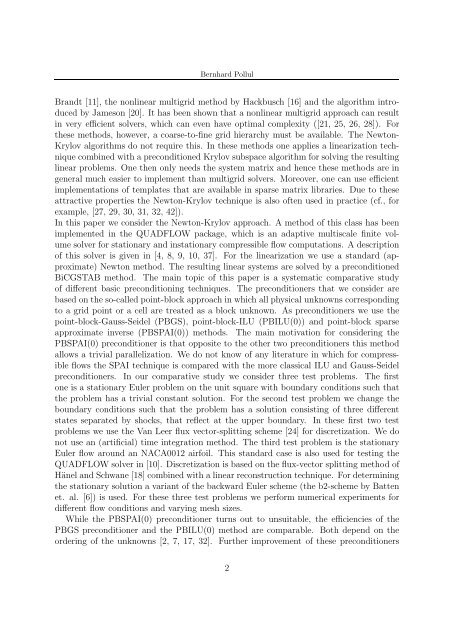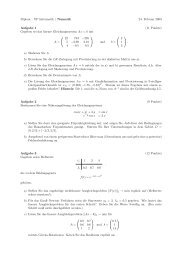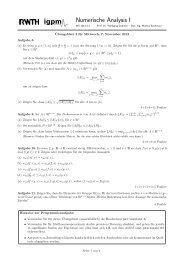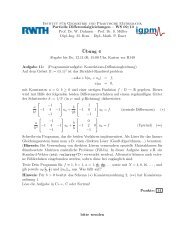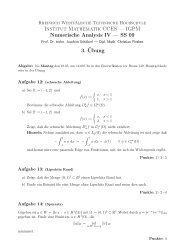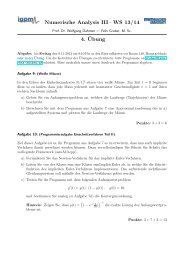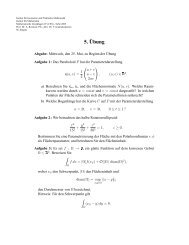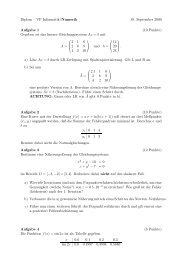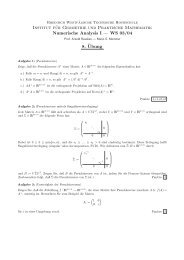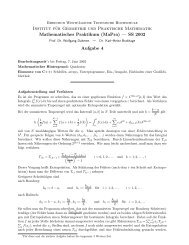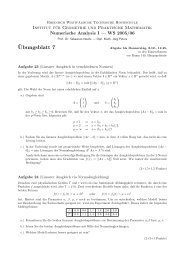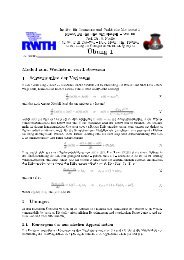preconditioners for linearized discrete compressible euler equations
preconditioners for linearized discrete compressible euler equations
preconditioners for linearized discrete compressible euler equations
Create successful ePaper yourself
Turn your PDF publications into a flip-book with our unique Google optimized e-Paper software.
Bernhard Pollul<br />
Brandt [11], the nonlinear multigrid method by Hackbusch [16] and the algorithm introduced<br />
by Jameson [20]. It has been shown that a nonlinear multigrid approach can result<br />
in very efficient solvers, which can even have optimal complexity ([21, 25, 26, 28]). For<br />
these methods, however, a coarse-to-fine grid hierarchy must be available. The Newton-<br />
Krylov algorithms do not require this. In these methods one applies a linearization technique<br />
combined with a preconditioned Krylov subspace algorithm <strong>for</strong> solving the resulting<br />
linear problems. One then only needs the system matrix and hence these methods are in<br />
general much easier to implement than multigrid solvers. Moreover, one can use efficient<br />
implementations of templates that are available in sparse matrix libraries. Due to these<br />
attractive properties the Newton-Krylov technique is also often used in practice (cf., <strong>for</strong><br />
example, [27, 29, 30, 31, 32, 42]).<br />
In this paper we consider the Newton-Krylov approach. A method of this class has been<br />
implemented in the QUADFLOW package, which is an adaptive multiscale finite volume<br />
solver <strong>for</strong> stationary and instationary <strong>compressible</strong> flow computations. A description<br />
of this solver is given in [4, 8, 9, 10, 37]. For the linearization we use a standard (approximate)<br />
Newton method. The resulting linear systems are solved by a preconditioned<br />
BiCGSTAB method. The main topic of this paper is a systematic comparative study<br />
of different basic preconditioning techniques. The <strong>preconditioners</strong> that we consider are<br />
based on the so-called point-block approach in which all physical unknowns corresponding<br />
to a grid point or a cell are treated as a block unknown. As <strong>preconditioners</strong> we use the<br />
point-block-Gauss-Seidel (PBGS), point-block-ILU (PBILU(0)) and point-block sparse<br />
approximate inverse (PBSPAI(0)) methods. The main motivation <strong>for</strong> considering the<br />
PBSPAI(0) preconditioner is that opposite to the other two <strong>preconditioners</strong> this method<br />
allows a trivial parallelization. We do not know of any literature in which <strong>for</strong> <strong>compressible</strong><br />
flows the SPAI technique is compared with the more classical ILU and Gauss-Seidel<br />
<strong>preconditioners</strong>. In our comparative study we consider three test problems. The first<br />
one is a stationary Euler problem on the unit square with boundary conditions such that<br />
the problem has a trivial constant solution. For the second test problem we change the<br />
boundary conditions such that the problem has a solution consisting of three different<br />
states separated by shocks, that reflect at the upper boundary. In these first two test<br />
problems we use the Van Leer flux vector-splitting scheme [24] <strong>for</strong> discretization. We do<br />
not use an (artificial) time integration method. The third test problem is the stationary<br />
Euler flow around an NACA0012 airfoil. This standard case is also used <strong>for</strong> testing the<br />
QUADFLOW solver in [10]. Discretization is based on the flux-vector splitting method of<br />
Hänel and Schwane [18] combined with a linear reconstruction technique. For determining<br />
the stationary solution a variant of the backward Euler scheme (the b2-scheme by Batten<br />
et. al. [6]) is used. For these three test problems we per<strong>for</strong>m numerical experiments <strong>for</strong><br />
different flow conditions and varying mesh sizes.<br />
While the PBSPAI(0) preconditioner turns out to unsuitable, the efficiencies of the<br />
PBGS preconditioner and the PBILU(0) method are comparable. Both depend on the<br />
ordering of the unknowns [2, 7, 17, 32]. Further improvement of these <strong>preconditioners</strong><br />
2


